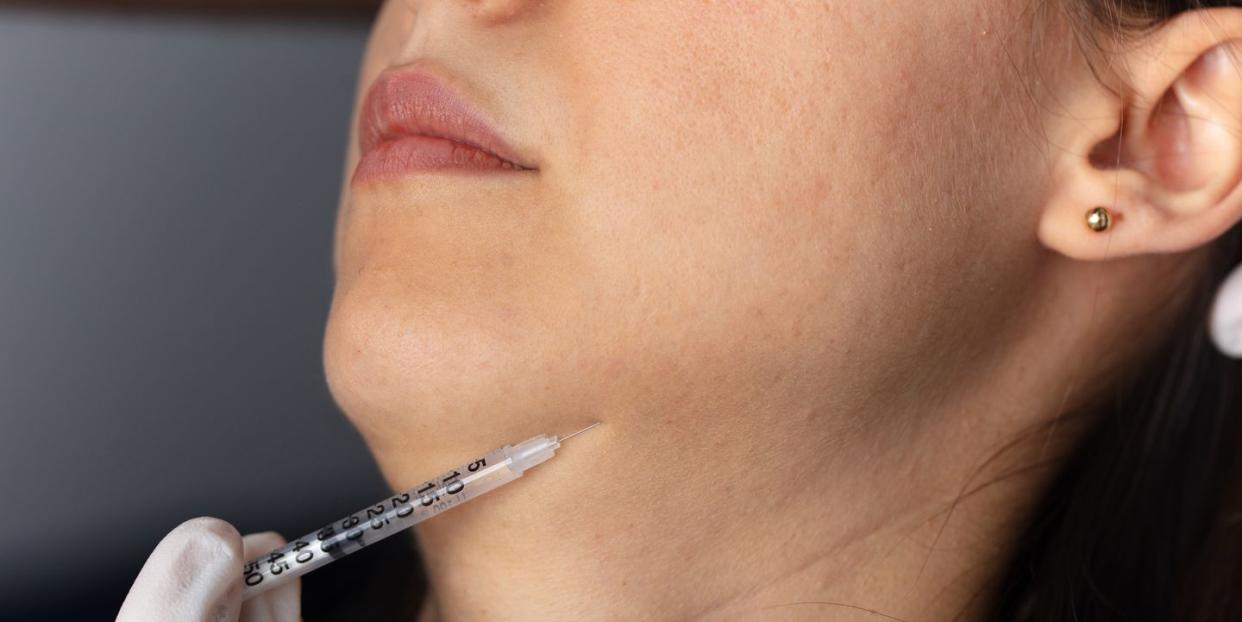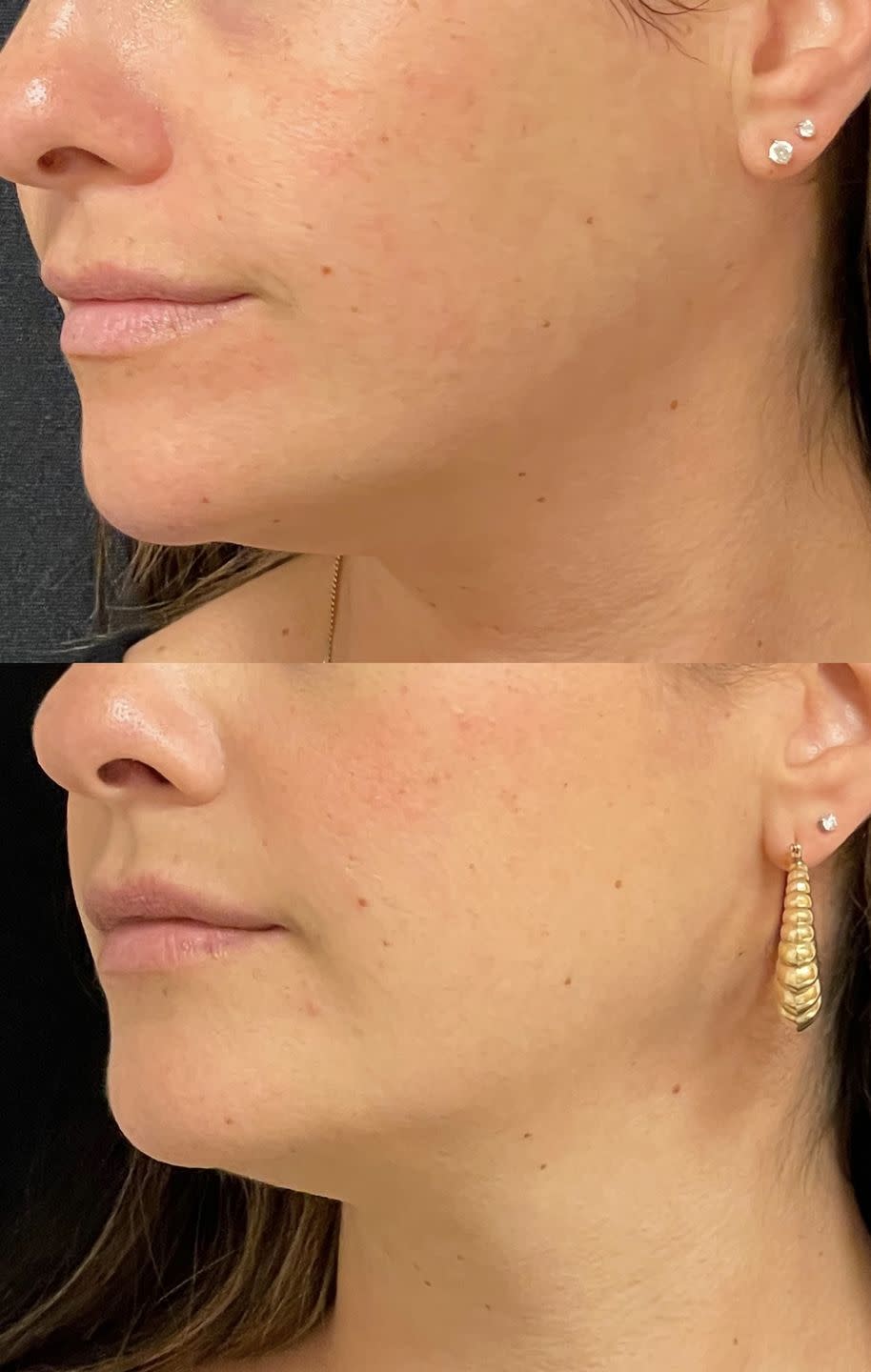Jawline Filler Is the Newest FDA-Approved Injection — and It's on the Rise

Facial fillers have become more popular and more advanced than ever. While they are a cosmetic procedure, filler injections are considered noninvasive, require minimal prep and downtime and can give visible results at a speed and level that you can't typically achieve with topical skincare products alone. Fans of fillers love the ability to create sculpted cheekbones, pillowy lips and smooth, bright under-eyes in a matter of minutes, but there's a new spot for filler that's on the rise: the jawline.
Similar to chin filler, jawline filler provides an option for those who want to strengthen the profile of their lower face without going under the knife. This less-invasive procedure for what industry pros call "lower facial optimization" is still fairly new: The Food and Drug Administration (FDA) only just approved the first filler product for the chin area in 2020, and another product specifically for the jawline last year in 2022.
Despite its newness, jawline filler is already trending. "Filler injection into the jawline is increasing in popularity, especially as more people are talking about it on social media," says Joshua Zeichner, M.D., a New York City-based board-certified dermatologist and Associate Professor of Dermatology and Director of Cosmetic & Clinical Research in Dermatology at Mount Sinai Hospital. A search for "jawline filler" returns over 298 million results on TikTok, and search interest is jaw filler has been increasing since the mid-2010s, seeing its peak in the last year.
What is jaw filler, and what does it do?
"Injectable fillers are products designed to be injected into the skin to help replace volume and restore structure," says Dr. Zeichner. Injectable fillers can be used all over the face, but jawline filler in particular is designed to create structure and definition along the jawline and chin.
What are the benefits of jaw filler?
"Filler can be injected in the angle of the jaw to elongate the jawline itself, and give a more defined look," says Dr. Zeichner. "This can also be injected between the jawline and the chin to hide the appearance of jowls."
Another pro: Fillers are temporary, dissolvable and less invasive than other cosmetic procedures for the area, like implants or liposuction, so they allow you the flexibility to test drive your altered appearance before potentially committing to a bigger, more drastic or more permanent procedure.
How does jawline filler work?
To mimic the appearance of a naturally strong jaw, an injector will place filler along the jaw and chin. "Fillers injected into the jawline typically are placed deep in the skin to help build and reinforce bony structure," says Dr. Zeichner. "For this reason, it is preferable to use a product that is more firm and consistent." He prefers to use Restylane, a dissolvable hyaluronic acid (HA) dermal filler, for the procedure (most commonly Restylane Lyft or Restylane Defyne, which was FDA-approved for chin augmentation in February 2021).
"I almost exclusively use hyaluronic acid fillers because they’re so versatile and they’re also reversible," says Dendy Engelman, M.D, a board-certified dermatologic surgeon at Shafer Clinic Fifth Avenue in New York City. She tends to opt for Juvederm Volux XC, which was FDA-approved for improvement of jawline definition in August 2022.
Aside from HA, there's also calcium hydroxyapatite (CaHA), a mineral found naturally in human bone and teeth tissue. CaHA fillers "do not attract as much water as HA fillers can and are said to result in a less puffy filling," says Birnur Aral, Ph.D., executive director of the GH Institute Beauty Lab.
Beyond its "immediate tightening and lifting effects, [there are also] longer-term bio-stimulatory effects that help build elastin and collagen," says Aral, which could mean it actually helps improve your natural facial structure over time. Another pro: Compared to HA fillers, CaHA "syringes contain more material, resulting in a more cost-efficient treatment," says Aral. Radiesse + uses CaHA and was approved for jawline enhancement and nasolabial folds in February 2022.
Are there any downsides of jaw filler?
The upside to filler can also potentially be its downside, depending on your goals: It's not as drastic or long-lasting a procedure as, say, liposuction or a chin implant, so you may not be able to achieve the level of change you're looking for. And of course, as with most medical procedures, there's always a risk for complications.
"There are important blood vessels and nerves that cross the jawline," explains Dr. Zeichner, and if those are accidentally injected, there's a risk for vascular occlusion that can restrict blood flow. That's why "a physician, familiar with facial anatomy, is a must to avoid rare but potentially serious complications," he says.
Dr. Zeichner adds that "more common side effects can include nodules in the skin or asymmetries between the left and the right sides." You may also likely experience swelling, bruising and tenderness around the injection site for up to a week.
How long does jaw filler last?
The ballpark figure is one-and-a-half to two years, but "injectable fillers can last anywhere from six months to several years," says Dr. Zeichner. "When injected at deeper levels, especially in areas where there’s not as much movement like the jawline, fillers tend to last for much longer periods of time."
How much does it cost to get jaw filler?
According to the dermatologists we spoke with, fillers can range in price between $800 and $1,500 per syringe, depending on the product and where you live.
As far as how many syringes of jawline filler you'll need: it's totally dependent on your natural anatomy and the results you want. For example, "It is not uncommon for me to inject four or more syringes in a single patient," says Dr. Zeichner, while also noting that some patients may only need half a syringe to get their desired outcome.
Dr. Zeichner says it's key to remember that "it takes five syringes to give you one teaspoon worth of volume," and since jawline "fillers are injected deep, it often takes larger volumes to give you the desired outcome," so this particular procedure may require more syringes (and therefore boast a higher price tag) than other facial injection sites.
Who should — and shouldn't — get jaw filler?
Jaw filler is perfectly fine for anyone who wants it and believes the procedure is worth it, but Dr. Engelman recommends it particularly for "patients who have a weak jawline, have jowling as a result of aging or genetics or people who just want more structure."
She adds, "while fillers do wonders, there are also limitations. I tell my patients that fillers can enhance, but they are not going to change you." If you're looking for a more drastic change in your appearance — or, of course, if you don't have any qualms with your jawline in the first place — jaw filler may not be for you.
Does jawline filler hurt?
"The good news about these fillers is that they come premixed with lidocaine, so with the exception of the initial prick, you will only be feeling pressure for the injection and when we massage the product," says Dr. Engelman.
While the pain level is low during the actual procedure, it may feel strange as the filler enters, and the physical manipulation of the filler immediately following injection can be a bit uncomfortable. Expect soreness, swelling and bruising for at least one week following the procedure — it can feel like downtime after minor dental work.
What to expect at your appointment
First, you'll have a consultation with your injector — a dermatologist, cosmetic surgeon, physician's assistant or nurse practitioner — so you can explain your goals and get on the same page about realistic results. During this time, your injector should observe your bone structure, how your facial muscles work and ask questions to understand your lifestyle and habits to make a treatment plan that will best suit your desires and give you the most favorable results.
Then, your face will be cleansed and wiped down with alcohol before a topical numbing solution is applied. After 30 minutes, the gel is removed and your face is cleaned once more before the injections are administered. Your injector will massage the product immediately post-injection to ensure it's in the correct spot.

There may be a series of injections along the jawline and into the chin as part of the procedure, and your injector may suggest adding filler to other parts of the face, like the cheeks, to help balance for facial optimization. You may hear some crackling as the filler enters, which can be surprising but is normal. The entire appointment will likely take an hour or so.
You Might Also Like

